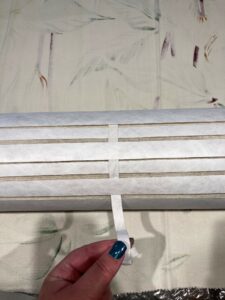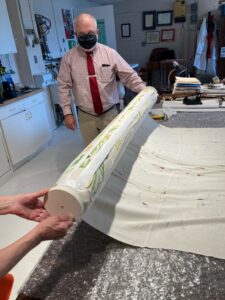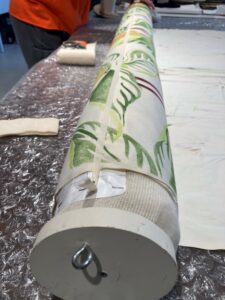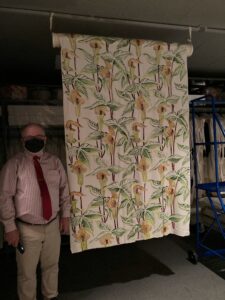Violet A. Gillett’s “Jack in the Pulpit” painted textile panel (New Brunswick Museum A49.34)
The New Brunswick Museum recently lent a number of works by New Brunswick artist Violet Gillett to the McCain Gallery in Florenceville, NB for a temporary exhibition. Among them was a long panel of rayon fabric hand printed by the artist in the 1940s in a pattern of jack-in-the-pulpit flowers. (NBM A49.34).
We decided to send this piece already mounted for exhibition. Due to the delicate nature and pristine condition of the artifact, we wanted to avoid either sewing the fabric to the mount or use of any adhesives, so we needed a mechanical fastening method. A collaboration between the NBM’s Conservator Dee Stubbs-Lee, Art Curator Peter Larocque, Collections Manager Cheryl Thorne and Humanities Collections Assistant Michelle Hébert resulted in a quick, inexpensive and effective solution based on friction fit and using materials already on hand.
We repurposed a padded, surgical stockinette jersey-covered cardboard tube that had been prepared for a previous textile exhibition. A 30 cm length of Tyvek was cut 4 cm wider than the fabric panel and cut into 5 widthwise parallel slits spaced at 2 cm intervals and stopping 2 cm from the edges of the Tyvek, which were then stapled to the jersey covered roller support. The top end of the artifact was woven through these slits, alternating over and under the Tyvek. The roller with the fabric artifact attached was then rolled to secure, allowing the free end to fall to the exact length agreed upon by the McCain Gallery and the New Brunswick Museum for the exhibition. To prevent further unrolling than desired, a twill tape stopper was stitched across the top of the roller, and screw eyes on the wooden end caps on the roller were adjusted to the proper angle for attachment to hooks to be installed from the ceiling in order to balance the textile in the correct position. The remaining free edge of the textile was then lined with acid free tissue and wound around the roller mount, secured with twill tape ties, and wrapped in a protective covering of tissue and clear polyethylene wrapping for protection during transit from the NBM to the Gallery.
Finally, detailed installation and deinstallation instructions were written and accompanied the travelling condition report and the work which were hand couriered to the Gallery.




Clockwise from top left: Woven support structure for friction hold of the artifact, top end of artifact threaded through the friction mount, twill tape stopper which must be oriented at the top side of the mount for installation, trial installation.
- Dee Stubbs-Lee and Peter Larocque, New Brunswick Museum
